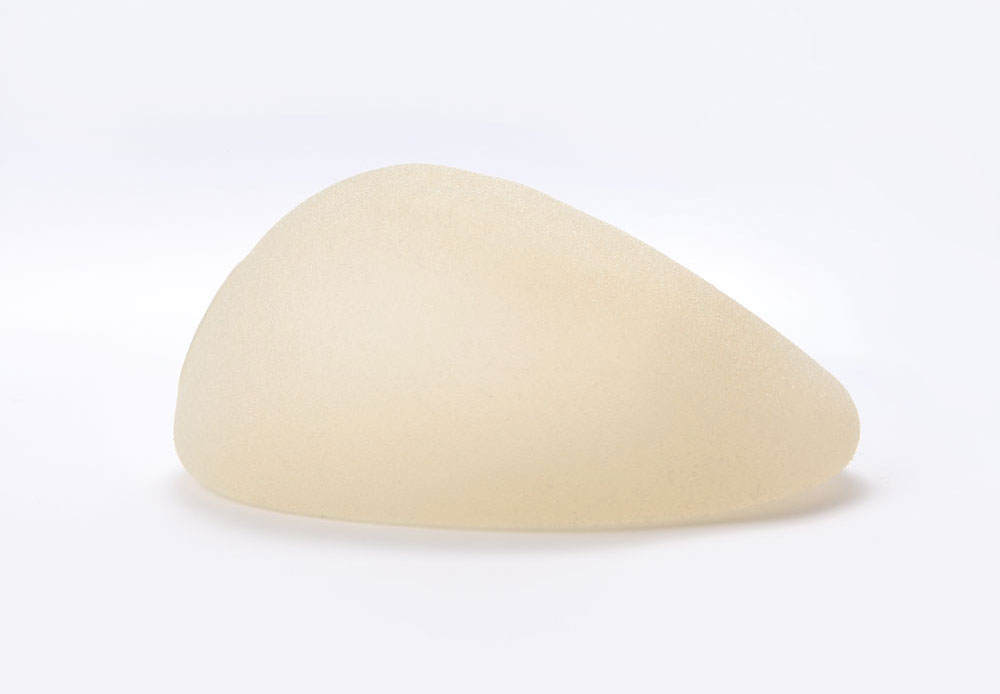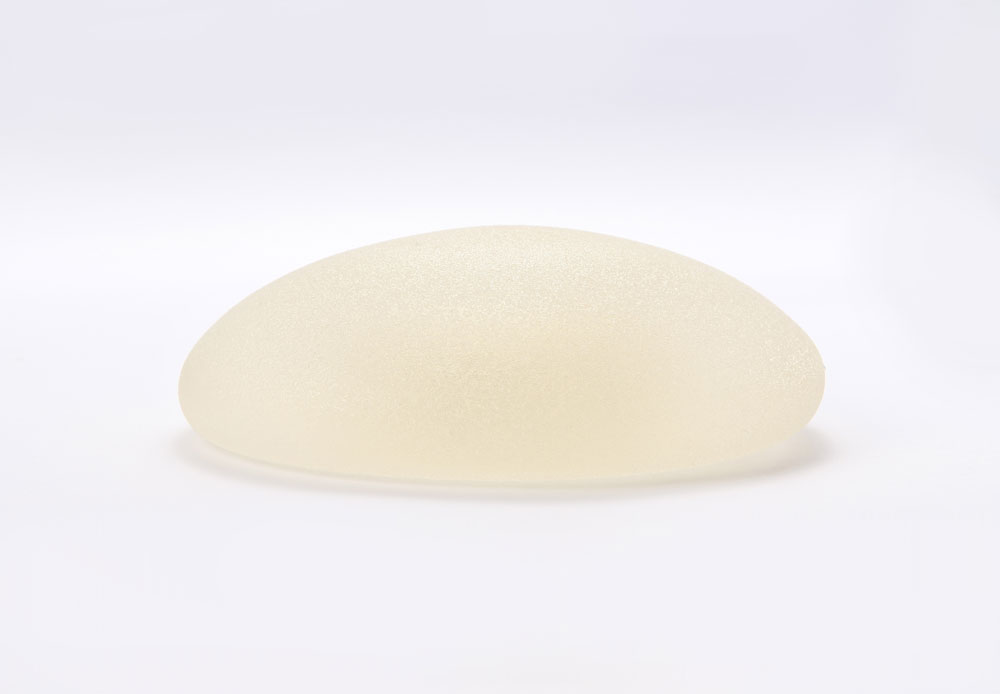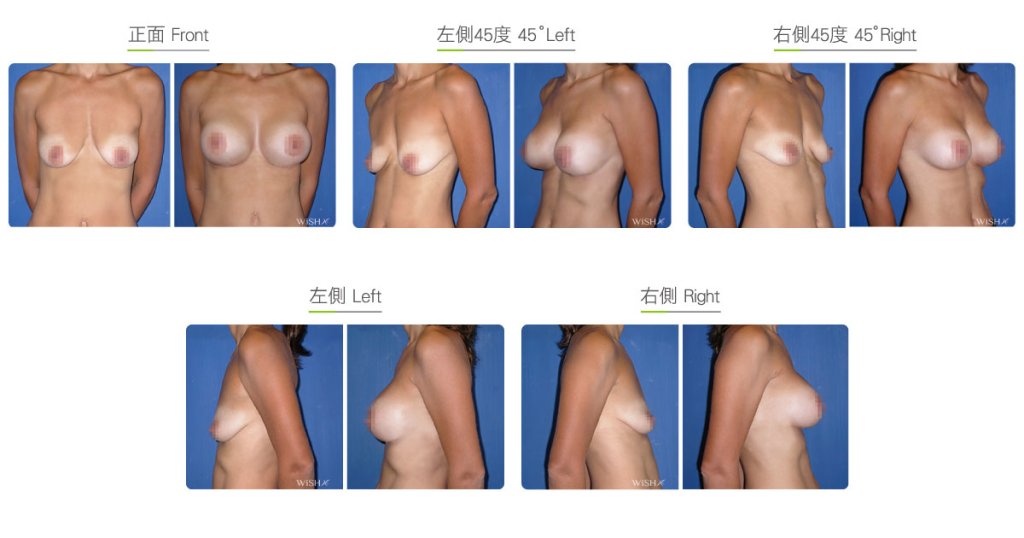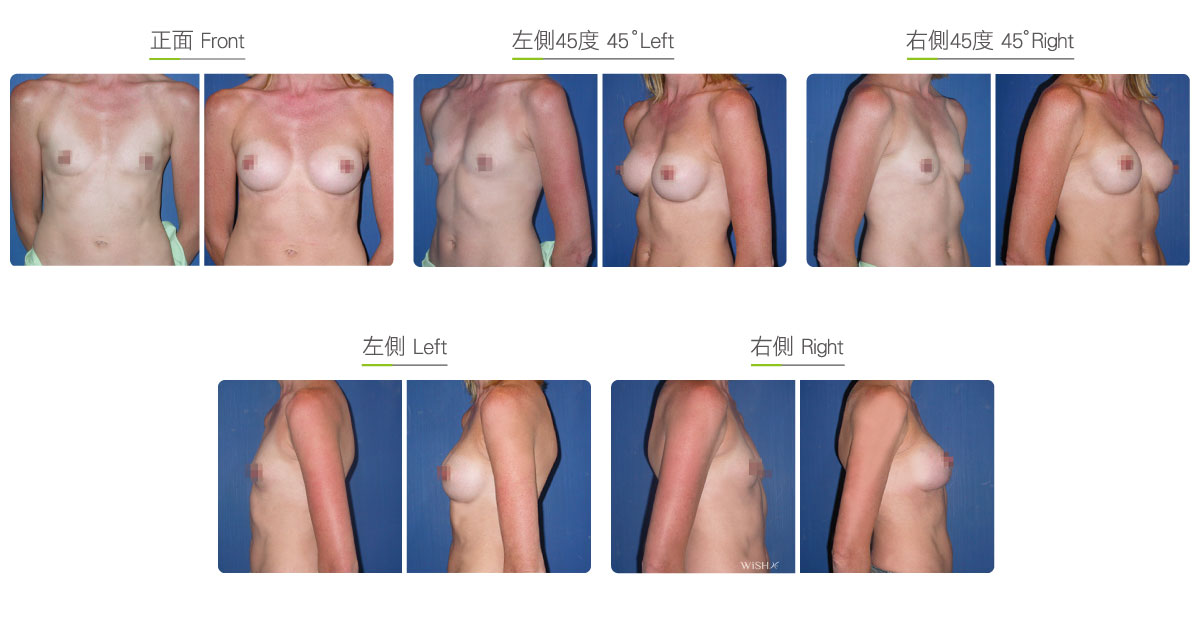Teardrop Implants
Teardrop or anatomical implants are the latest approved breast prosthetics. They are designed to be pyramidal, narrow at the top and wide at the bottom, resembling the shape of a water or tear drop. The surface of implants is made of multilayer processed textured material; therefore, they are also called “textured peach” or “gummy bear” implants. Their fillers are cohesive type III silicone gel, which are harder than the common silicone gel used for smooth implants but better for the maintenance of breast form and firmness. These fillers allow the breasts to set into the teardrop shape of implants faster after the procedure and save a lot of efforts in terms of postoperative massaging and shaping. Thus, they have become the preferred choice for many patients undergoing breast augmentation procedures in countries such as Europe, America, Japan, and Korea.
Besides the difference in shape, another characteristic of teardrop implants is that they are less likely to cause severe capsular contracture; only capsular contracture up to grade 2 can occur. The main reason is that cusps serves as “breaking” points that prevent tissues from covering the whole implants too quickly and easily, as observed when using round implants. Furthermore, fine particles on the textured surface of the outer shell can prevent capsule formation and implant movement, allowing these implants to have a more easily maintained shape and avoid complications such as breast deformation and malposition caused by capsular contracture. Hence, they are also frequently used in patients undergoing secondary breast augmentation (revision mammoplasty) or those with repeated capsular contractures, showing higher success rates than round implants.
However, teardrop implants are not without shortcomings. To support breast shape and resist capsular contracture, type III silicone gel fillers are harder than the type I silicone gel used for round implants, making the touch of these implants the worst limitation. They are not ideal for patients with flat breasts or thin skin because implant edges or wrinkles can be easily felt. In addition, the cusps of implants have to be properly aligned. If a patient frequently massages the breasts or performs vigorous exercise, implants could move and cause unforeseen changes to breast shape. Along with patient adaptation and usage of these implants, the choice of implant style and size made by the physician is also a crucial determining factor in whether one can achieve a perfect result. In particular, because these implants are made with precise volume calculations by manufacturers, there are hundreds of styles depending on the base length, width, and height. Choosing the most appropriate implant size for patients requires abundant experience and knowledge; it is a true testament of a physician’s esthetic sense and standards.
The placement of teardrop implants is very different from that of traditional round smooth implants. The standard incision site is inframammary because it allows the precise placement of implants’ triangular shape and prevents implant displacement. However, because Asian skin is more likely to have visible scars at this incision site, patients can still choose transaxillary incision for teardrop implant placement using an endoscopic procedure. This procedure creates a pocket matching the size of teardrop implants. If excessive space is created, implants could slide and move. Thus, an endoscopic procedure is used to ensure successful results. The placement site of implants is the same as that for round implants; submuscular and subfascial placements can both be performed depending on patients’ conditions. However, if postoperative natural look and touch are taken into consideration, submuscular placement would be more appropriate.
Dr. Chuang has years of experience with various implant breast augmentation surgeries and has his own beauty sense for choosing the volume and type of teardrop implants. To further ensure the adaptability of these implants in different patients, patients who select teardrop implants would undergo preoperative 3D breast imaging using the latest technology, Axisthree 3D simulation system, to simulate the effects of different sizes and types. Thus, patients can easily choose their preferred breast shape from simulated images. Dr. Chuang can then complete the surgery using the image. This protocol not only allows patients to predict surgical results but also ensures the precision of teardrop implant size, effectively elevating the satisfaction with this type of breast augmentation. For patients who would like teardrop implants but have inadequate skin conditions, Dr. Chuang also offers hybrid mammoplasty combining autologous fat transfer with teardrop implants. This surgery injects an adequate amount of fat near the midline and upper part of the breast after implant placement. Using fat to thicken the skin covering implants improves touch, effectively reduces the chances of implant wrinkling or rippling, and allows a more realistic breast appearance. These remarkable breast implants and surgical techniques allow thin patients to achieve both a natural look and shape.
Comparison between teardrop and round implants


When all conditions fit for a breast augmentation, tear-drop implants can provide a more desired lifting shape of breasts.
Surgical conditions
Duration
- Type of anesthesia: General anesthesia
- Type of incision: Transaxillary, periareolar, or inframammary incision
- Recovery: Within 2–3 days
- Removal of stitches: 7–10 days
General instructions
No food and water on the day of surgery
- Frequent stretching should be performed for 1 month postoperatively to prevent axillary scar adhesion.
- Tasks and exercises that require excessive arm strength should be avoided, and underwired or push-up bras should not be worn for 3 months postoperatively.
- Special bras may need to be worn for 3 months postoperatively to stabilize implant position.
Ideal candidates
- Those who highly desire perfect teardrop breasts
- Those with adequate breast tissue (B cup or larger) and who seek faster shape formation
- Those who ask for the C cup breasts but with the teardrop shape result
- Those who cannot go through postoperative massage
- Those who are concerned about complications such as capsular contracture and breast deformation
- Those who have undergone unsuccessful breast augmentation with round implants
- Those with special breast shapes (such as tuberous breasts) and would like a perfect reconstruction
- Those requiring breast reconstructions after mastectomy
Possible complications
- Implant displacement
- Splayed breasts
- Less concentrated cleavage
- Scar adhesion (underarms)
- Presence of implant edges or ripples
- Implant leakage or rupture
Surgical advantages
-
Fast formation of teardrop breasts
-
Minimal postoperative pain and no massage required
-
Shorter surgical procedures and quicker recovery
-
Stable breast shape not prone to deformation
-
Very low chance of capsular contracture (<10%)
Surgical drawbacks
-
Implants are not as soft to touch as smooth implants.
-
Those with less ideal breast implant conditions may show implant edges or wrinkles
-
The breasts appear more firm or unnatural when lying on the back.
-
Harder to create a concentrated cleavage
-
Implants could move due to excessive use, exercise, or compression.
Possible procedures in conjunction
Comparison between teardrop and round implants
|
Teardrop Implants
|
Round Implants
|
|
|---|---|---|
| Ideal candidates | Those with satisfactory conditions for implants or breast size larger than B cup | No limitation on patient conditions |
| Implant shape | Pyramidal, like a teardrop | Flat round disk |
| Outer shell material | Textured particles | Either smooth or textured surface |
| Inner filling | Type III silicone gel | Type I silicone gel |
| Size choices | Many | Fewer |
| Incision type | Inframammary incision preferred | Mainly transaxillary |
| Incision size | Longer (approximately ≥4 cm) | Shorter (3–4 cm) |
| Implant placement | Mainly submuscular | Either subfascial or submuscular |
| Pocket size | Smaller | Larger |
| Implant mobility | Fixed in front of the chest | Movable |
| Teardrop breast formation | Fast | Slower |
| Softness | Relatively hard | Soft like real breasts |
| Cleavage | More difficult | Can have a deep V shape |
| Capsular contracture chance | Lower (<10%) | Higher (10%–15%) |
| Postoperative massage | Not necessary | Necessary |
| Bra wear | Special bras for shape stabilization | Not recommended for 3 months following surgery |


